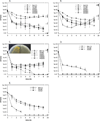Staphylococcus aureus persisters tolerant to bactericidal antibiotics
- PMID: 22986269
- PMCID: PMC3518770
- DOI: 10.1159/000342449
Staphylococcus aureus persisters tolerant to bactericidal antibiotics
Abstract
Bacterial persister cells are non- or slow-growing reversible phenotypic variants of the wild type, tolerant to bactericidal antibiotics. We analyzed here Staphylococcus aureus persister levels by monitoring colony-forming unit counts of planktonically grown cells treated with six different antimicrobials over time. The model laboratory strains HG001-HG003, SA113 and the small colony variant (SCV) strains hemB and menD were challenged by the compounds at different logs of minimal inhibitory concentration (MIC) in exponential or stationary growth phase. Antibiotic tolerance was usually elevated in SCV strains compared to normally growing cells and in stationary versus exponential phase cultures. Biphasic killing kinetics, typical for persister cell enrichment, were observed in both growth phases under different selective conditions. Treatment of exponential phase cultures of HG001-HG003 with 10-fold MIC of tobramycin resulted in the isolation of persisters which upon cultivation on plates formed either normal or phenotypically stable small colonies. Trajectories of different killing curves indicated physiological heterogeneity within persister subpopulations. Daptomycin added at 100-fold MIC to stationary phase SA113 cells rapidly isolated very robust persisters. Fractions of antibiotic-tolerant cells were observed with all S. aureus strains and mutants tested. Our results refute the hypothesis that S. aureus stationary phase cells are equivalent to persisters, as not all of these cells showed antibiotic tolerance. Isolation of S. aureus persisters of different robustness seems to depend on the kind and concentration of the antibiotic, as well as on the strain used.
Copyright © 2012 S. Karger AG, Basel.
Figures





Similar articles
-
Recalcitrant Staphylococcus aureus Infections: Obstacles and Solutions.Infect Immun. 2021 Mar 17;89(4):e00694-20. doi: 10.1128/IAI.00694-20. Print 2021 Mar 17. Infect Immun. 2021. PMID: 33526569 Free PMC article. Review.
-
Interplay between population dynamics and drug tolerance of Staphylococcus aureus persister cells.J Mol Microbiol Biotechnol. 2012;22(6):381-91. doi: 10.1159/000346073. Epub 2013 Jan 25. J Mol Microbiol Biotechnol. 2012. PMID: 23363876
-
Daptomycin pharmacodynamics against Staphylococcus aureus hemB mutants displaying the small colony variant phenotype.J Antimicrob Chemother. 2009 May;63(5):977-81. doi: 10.1093/jac/dkp069. Epub 2009 Mar 19. J Antimicrob Chemother. 2009. PMID: 19304733
-
Glucose Augments Killing Efficiency of Daptomycin Challenged Staphylococcus aureus Persisters.PLoS One. 2016 Mar 9;11(3):e0150907. doi: 10.1371/journal.pone.0150907. eCollection 2016. PLoS One. 2016. PMID: 26960193 Free PMC article.
-
Multidrug tolerance of biofilms and persister cells.Curr Top Microbiol Immunol. 2008;322:107-31. doi: 10.1007/978-3-540-75418-3_6. Curr Top Microbiol Immunol. 2008. PMID: 18453274 Review.
Cited by
-
Recalcitrant Staphylococcus aureus Infections: Obstacles and Solutions.Infect Immun. 2021 Mar 17;89(4):e00694-20. doi: 10.1128/IAI.00694-20. Print 2021 Mar 17. Infect Immun. 2021. PMID: 33526569 Free PMC article. Review.
-
Fusion with a cell wall binding domain renders autolysin LytM a potent anti-Staphylococcus aureus agent.FEMS Microbiol Lett. 2015 Jan;362(2):1-7. doi: 10.1093/femsle/fnu035. Epub 2014 Dec 8. FEMS Microbiol Lett. 2015. PMID: 25670705 Free PMC article.
-
Antibiotic release from F-doped nanotubular oxide layer on TI6AL4V alloy to decrease bacterial viability.J Mater Sci Mater Med. 2018 Jul 20;29(8):118. doi: 10.1007/s10856-018-6119-4. J Mater Sci Mater Med. 2018. PMID: 30030636
-
An Enzybiotic Regimen for the Treatment of Methicillin-Resistant Staphylococcus aureus Orthopaedic Device-Related Infection.Antibiotics (Basel). 2021 Sep 29;10(10):1186. doi: 10.3390/antibiotics10101186. Antibiotics (Basel). 2021. PMID: 34680767 Free PMC article.
-
Characterization of blue light irradiation effects on pathogenic and nonpathogenic Escherichia coli.Microbiologyopen. 2017 Aug;6(4):e00466. doi: 10.1002/mbo3.466. Epub 2017 Mar 22. Microbiologyopen. 2017. PMID: 28332311 Free PMC article.
References
-
- Balaban NQ, Merrin J, Chait R, Kowalik L, Leibler S. Bacterial persistence as a phenotypic switch. Science. 2004;305:1622–1625. - PubMed
-
- Baltch AL, Ritz WJ, Bopp LH, Michelsen P, Smith RP. Activities of daptomycin and comparative antimicrobials, singly and in combination, against extracellular and intracellular Staphylococcus aureus and its stable small-colony variant in human monocyte-derived macrophages and in broth. Antimicrob Agents Chemother. 2008;52:1829–1833. - PMC - PubMed
Publication types
MeSH terms
Substances
Grants and funding
LinkOut - more resources
Full Text Sources
Other Literature Sources
Medical
Molecular Biology Databases

